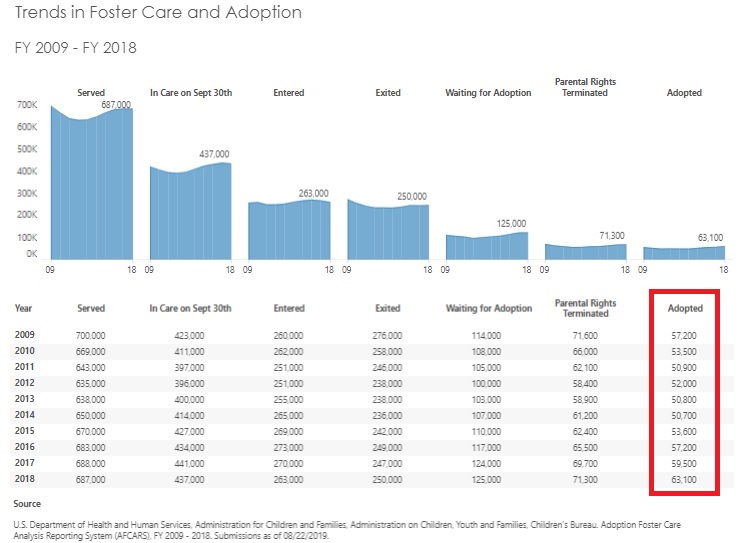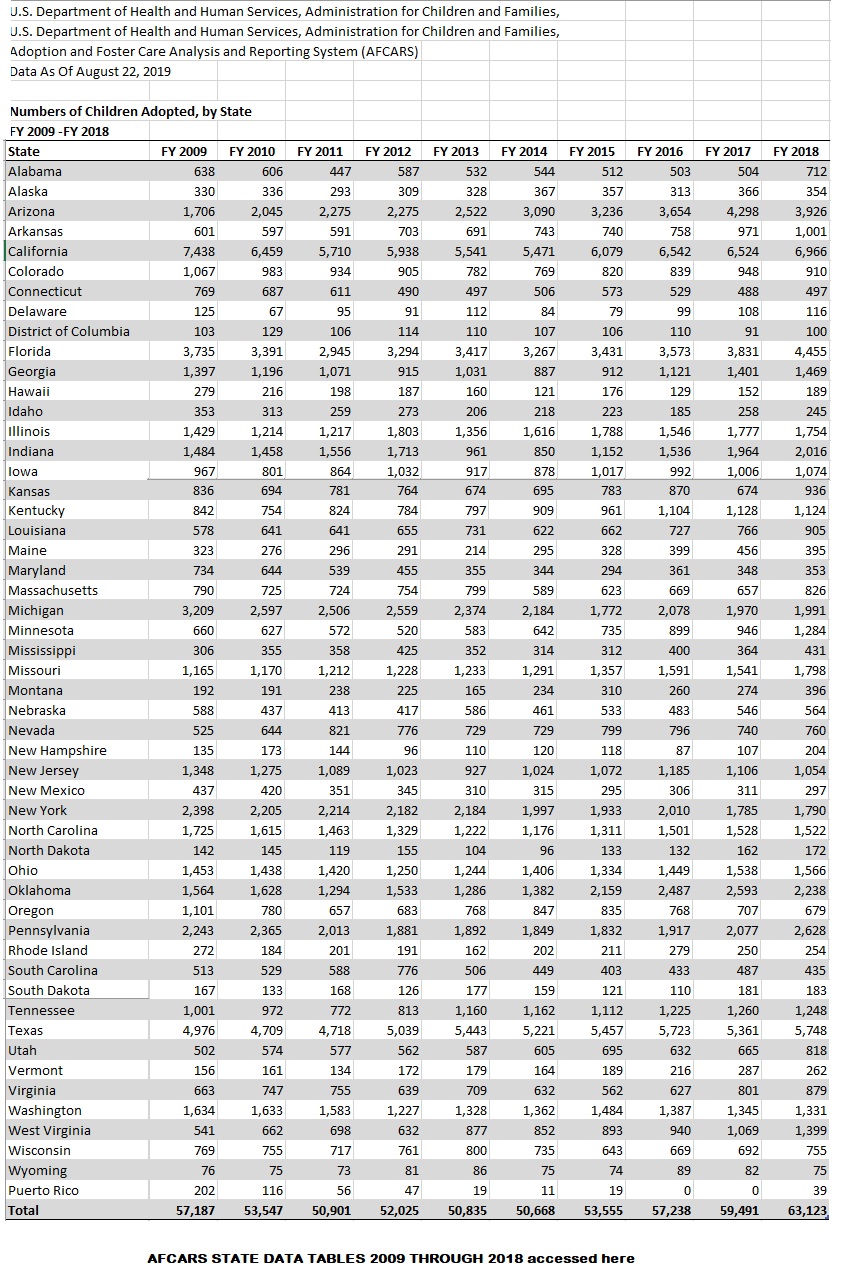Data compiled from the U.S. Administration for Children and Families (ACF) reporting through fiscal year 2018 reveals that “the number of children in foster care, although still very high, dropped for the first year since 2011,” and there have been a record number of adoptions. Despite room for major improvement, the National Council for Adoption (NCFA) called the report good news due to an 11% increase in adoptions over the course of five consecutive years, and a six percent increase in just one year — from 59,500 adoptions in FY 2017 to 63,100 adoptions in FY 2018.
“[T]he highest number of children in [foster] care in the 21-year history of the report was 567,000 children in FY 1999,” NCFA noted.

Trends in Foster Care and Adoption 2009 to 2018 (Chart: Admin of Children and Families )
According to ACF, the data from the Adoption and Foster Care Analysis and Reporting System (AFCARS) showed that the number of children in care at the end of FY 2018 had decreased from 441,000 reported end of FY 2017 to 437,300 end of FY 2018.
In 2018, the number of children entering care also dropped from 270,000 in FY 2017 to to 263,000,” ACF reported.
FOSTER CARE ADOPTIONS:
Adoptions for FY 2018 within the U.S. child welfare agency increased to the “largest number of adoptions reported by AFCARS since AFCARS data collection began in FY 1995.” A review of trends in foster care and adoption revealed that:
- The annual number of finalized adoptions remained relatively flat during FYs 2011, 2012, 2013 and 2014.
- FY 2015’s 53,600 adoptions represented a nearly 6 percent increase over FY 2014’s 50,700.
- Each year since FY 2015, adoptions have increased to a historic high of 63,100 in FY 2018.
- Between FYs 2009 and 2015, adoption has remained very stable, making up on average 21% of the discharges from foster care each year.
- Beginning with FY 2016, there has been at least a percentage point increase in adoptions as a percentage of foster care discharges to a high of 25 percent during FY 2018.
A review of state-by-state data by NCFA found that in 2018, New Hampshire nearly doubled its adoptions in the past year. NCFA also pointed out that Alabama, Kansas, Minnesota, and Montana “made significant strides in increasing adoptions in FY 2018.”

ACF Adopted from Foster Care FY2009 thru 2018
But despite reuniting several of these children with their biological parents, ACF warned, “Although the number of adoptions in the most recent year set a new record, the number of children waiting to be adopted increased to 125,400 in FY 2018 compared to 123,800 in FY 2017.”
According to ACF:
Approximately 94,400 children were removed from their home in FY 2018 because of parental substance abuse. Neglect continues to be the main reason why a child is removed from a home and placed into foster care. In FY 2018 163,500 children were removed from their home because of neglect, a decrease from nearly 167,000 in FY 2017.
In fact, they report that “[t]he number of children waiting for adoption has increased over the last five years, from 106,600 in fiscal year (FY) 2014 to 125,400 in FY 2018.” About one in five of those children waiting to be adopted are teenagers. Sadly, “[t]eenagers between the ages of 15- to 17-years-old wait on average twice as long for an adoptive home, compared to children who are 14 years of age and younger,” the report states.
In an effort to promote adoption, the agency has released a number of Public Service Announcements (PSAs):
But ACF clarified that even though numbers have changed, the percentage of children waiting to be adopted has not:
As numbers of children in care were declining, the numbers waiting for adoption also declined. As the year end count began to increase as it has in the last six years, the numbers of children waiting for adoption has also grown going from a low in FY 2012 of 100,000 up to 125,000 in FY 2018. However, the percentage of children who are defined as waiting to be adopted has remained stable over the last decade, averaging between 26 and 28% of children in care on the last day. [emphasis added]
NCFA also reported that:
The number of youth who aged out of care fell a significant 11% in just the past year. At 17,844, the number of emancipated youth is now the lowest since FY 1998, which was the first year that data was collected by the AFCARS report. This significant 20-year low is in part due to increased efforts to find adoptive families for older youth as well as efforts by states to expand foster care services to the age of 21.
Watch one family’s story of how they began to foster to adopt:
According to the website AdoptUsKids.org, many of the children that age out of foster care “will not have anyone they can call for help, for advice, for a ride when their car breaks down. It’s disturbing, but probably not surprising, that outcomes for youth who age out of foster care are often poor. Studies show that they are at increased risk for homelessness, young parenthood, low educational attainment, high unemployment rates, and other adverse adult outcomes.”
To help these vulnerable children find their forever homes, AdoptUsKids.org has several tools, including thousands of children photolisted along with state by state adoption and foster care information.
“Like” Live Action News on Facebook for more pro-life news and commentary!







